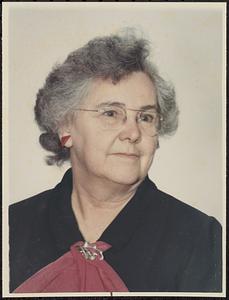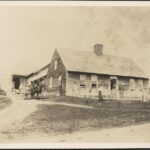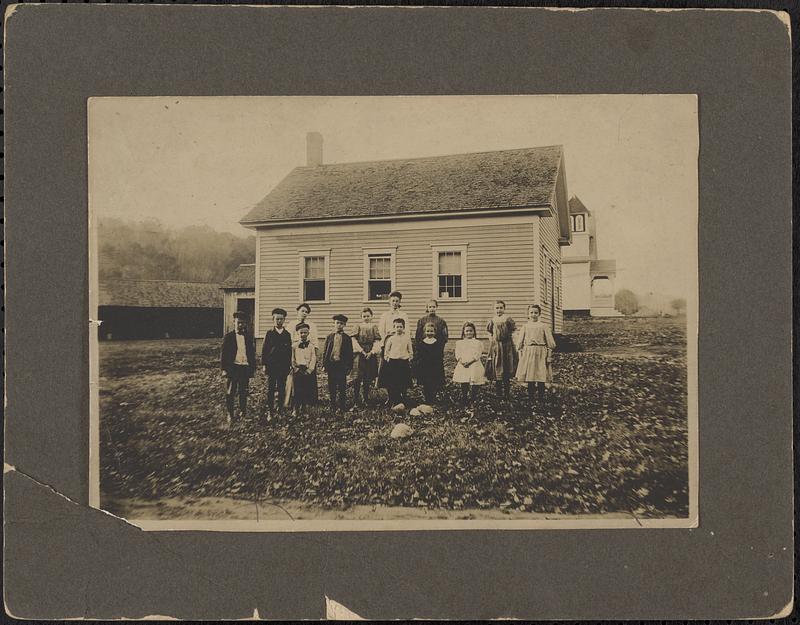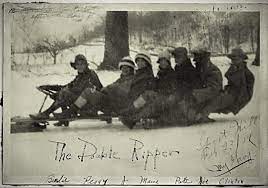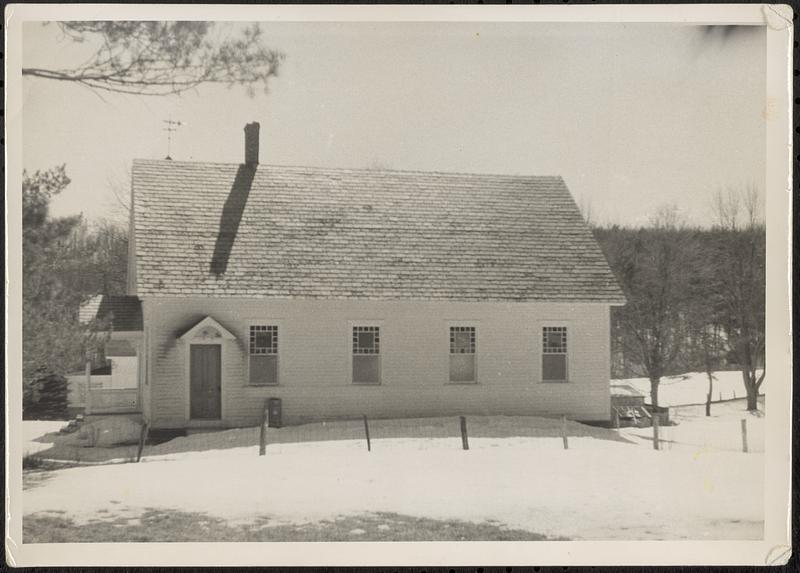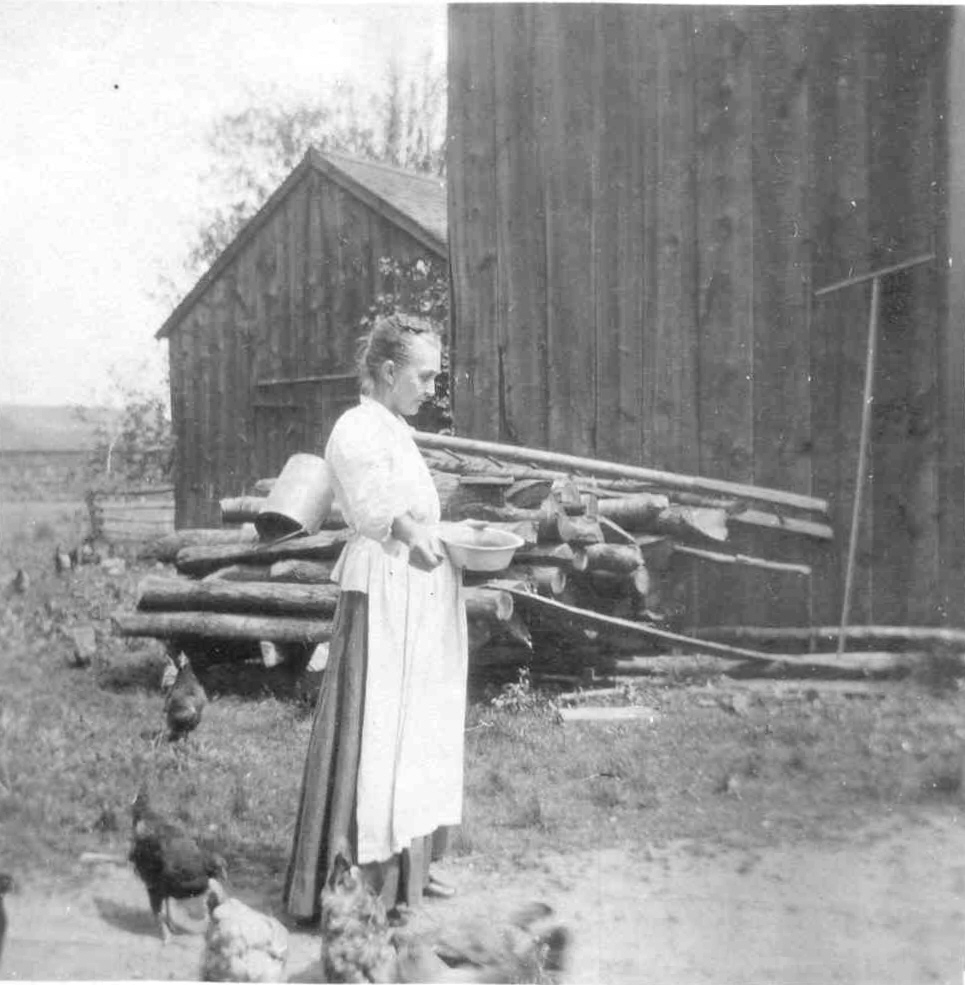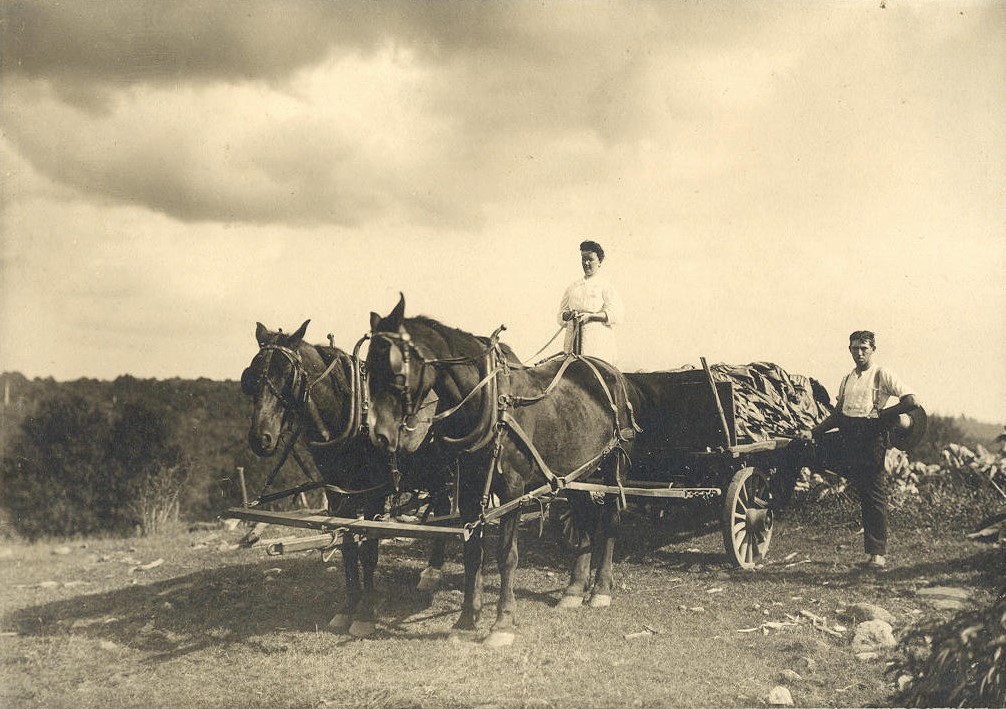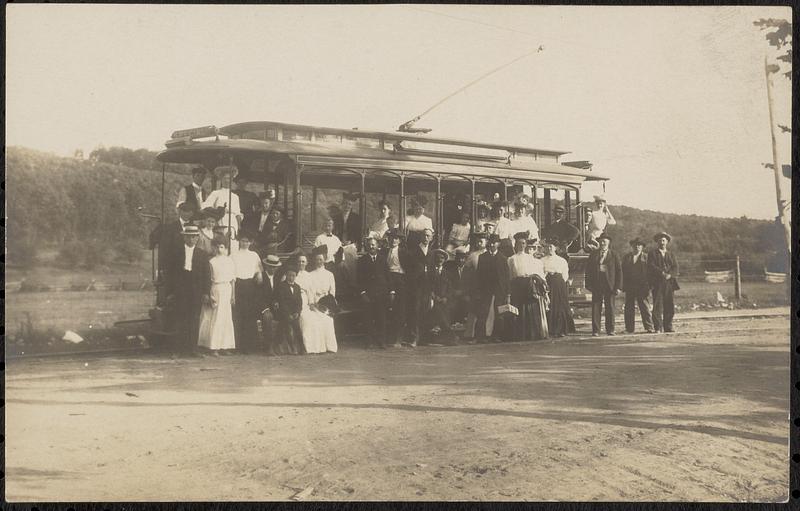by Susie Sanderson, 1985 (Transcribed and edited by Dereka Smith and Neal Abraham, 2024)
Our parents were Lenny and Minnie Sanderson. There were five children in our family. They were Mildred, Jenny, Clifford, Susie and Emery. In 1900 to 1910 we lived in a fine old house https://whatelyhistorical.org/with shutters of wood over the windows in the north bedroom. The shutters were to protect against Indians. The house was near where Barry Baldwin built. It burned and at that time was one of the oldest houses in Whately. It was owned most recently by Harold and Grace Adkins. We went to West Whately school. The building near the Chapel has been built into a home. There were 20 to 30 children and one teacher. The older pupils worked with the little ones. It was taught during all the school days of Mildred and Jenny by Bertha Hodges who married Leslie Waite. We had a few teachers for a year or so they were Miss Pringle, Fannie Hosmer and Esther Warner. [Esther Warner} was our favorite teacher. She married Howard Waite and now lives in Whately. When Howard came on Friday to take her home we would hide and holler “teacher’s got a feller.” Many of the teachers boarded with Mrs. Adkins.
Emery and I walked to school. After we got older we were janitors. We were paid $5 a year. We built a fire in the pot belly stove, swept the floor and cleaned the blackboards. We went to get drinking water in a pail from a spring at the third bridge on the Williamsburg Rd. We had a long handled dipper which we all drank out of. Germs were not heard of then. We had double desks with two students at each desk.
Our toilets were three holers back by the woodshed. It was a great way to get out of studying in warm weather but winter was a time to hurry. The recesses were wonderful with tag, hide and seek behind the horse barns, kick the can, king of the mountain, drop the handkerchief, etcetera.
The winter was special. We played making snowmen, forts, snowballing, etcetera. But best of all we went sliding on Vic’s hill (Victor Bardwell). We used a double ripper. It was a small sled to steer it and a long board with another sled in back. It would hold five or six children. The hill had thank you marms (big bumps to drain off the water) when the speed was up one sitting on the back bounced up and didn’t always hit the sled when he came down. The sad part was we couldn’t hear the bell (a handbell). Sometimes we didn’t make a real hard effort to hear it.
For a school bus, which dad drove, we had an express wagon or a sleigh over which he had made a cover frame with oil cloth over it to cover the children who lived too far away. School was seldom closed for storms in those days. We walked rain or shine, snow or blow. We had no electric lights or telephone then.
My older sisters tell that one day a big balloon came down near our house they all left school and ran to see it. It was a big event especially when an automobile drove up to see it. The first automobile that children had seen. I think the balloon man gave them candy.
The Chapel
The Chapel was built by men in the community. A minister from Haydenville came to hold services on Sunday PM. Later the Whately minister came. It was a very important gathering place.
We had an extra special Christmas tree there. Our prize was an orange. Oranges were very special in those days. We had weddings, funerals, showers etcetera. It was heated by a big heat wood burning stove. We had to bring water in.
A very special event was the $0.10 suppers which we had about once a month Everybody grew their own food, so they only had to buy sugar, coffee etc. all other food was donated. They were very popular. People came from Northampton and places around by horse and buggy. That is why about 8 horse sheds were built. The children spoke pieces put on plays and often entertained with songs. About 1901 the Chapel was moved from the left side of the Williamsburg Rd. so that the city of Northampton could build a reservoir. Church services are held here for three weeks in the summer. We enjoyed using it then. My sister Mildred married Arthur Bean in this Chapel in 1925.
Lately community help has painted it. We are planning other important repairs. It means a lot to older members of the community. (1985)
Work
We all had to work. I remember riding horseback and going back and forth through the rows of corn while dad held the cultivator as the horse pulled it. It got mighty hot some days. I remember vividly going over to a cornfield located where Swamp Rd. joins 5 and 10. This day many men on horses of our United States cavalry went down route 5 and 10. It was quite an impressive sight.
Another time a big group of gypsies went by. That was really frightening, for along with it went stories of how they carried off children. We all had to help raising tobacco. It was our only money crop then except for milk which we sold. We had only a small field at the old house We built frames, put glass over it for a hot bed.
We had to steam the ground to kill the weed seeds. A man came on Easter with the big steamer machine. Dad put eggs in the ground and later we enjoyed hard boiled eggs. When the plants grew to about 5 or 6 inches tall, they were pulled up and planted in rows in the field with a tobacco setter. A big barrel with water in the center, seats for two persons were low down. It was drawn by horses. A plant was watered as it was set in the ground.
We helped with all the processes needed in growing tobacco. Pulling small plants from the hot bed, setting plants in the field, weeding, hauling, topping and suckering, cutting, loading and passing the plants to tie to a pole in the barn. Later when cured we had to strip the leaves from the stalks. The saddest time of all was when a heavy hailstorm came just before it was cut. Our whole summer work was all for not [sic].
Our cows were important for a little income. We had 10 cows in the barn with chains to tie them with. There was a big water tank inside the door which was always full of water. A small stream was running in all the time. The chains were later changed to stanchions. The milk was cooled in a big tank of cold water; sometimes ice had to be added. It was then taken to a train in North Hatfield and later collected at the farm.
The crops were tobacco, corn, and hay. Haying was a much harder job then than now. It was put into the bay loose. it had to be packed into the corners and tramped down. After mowing with machine, then with scythe around the edges of each field, it dried and then was raked by hand into windrows. Next stacked into forkfuls, then loaded onto a two-horse wagon, a forkful on each corner, then one in the middle, working back each layer the same until a big load was taken to the barn. It was pitched into the bay until it was crammed to the very peak. All we could get in. We bought standing grass from Mrs. Billings’ farm where Mike Farrick now lives and also from Montville Crafts’ farm across from where Alice Grafflin now lives. The trying times were when thunder and lightning drove us to hurry.
We raised two or three acres of corn for pigs and chickens.
Later our pasture was up on Dry Hill about two miles from home, Emery’s job was after the cows were milked to drive them in the morning up to pasture then back in time to go to school.
After cars became plentiful we milked under an open shed in the pasture. There were years when Dad raised many chickens and Emery peddled eggs to customers in Greenfield with the Franklin. It took less gas when gas was rationed. We also raised lots of strawberries. The neighbor children helped pick them for $0.05 a quart. These were sold around in Hatfield and South Deerfield. Woe to the girl who came to pick wearing shorts. She was sent right home. (Shorts were not much then.)
Dad also raised many long rows of tall telephone peas. They were beautiful and were sold to stores along with the eggs. They were bushed with white birch branches, it was a hard job. We all had to work. The wood box had to be filled for heating and cooking. The girls had to help with the garden and canning. We all worked haying and had to help feeding cattle, horses, pigs and chickens. Often I remember weeding onions for Louis Webber. That I remember made my knees bleed because of stony land. Anyway I earned enough to buy a winter coat and Emery bought a liberty bond. The rows were endless. Emery rode a horse for cultivating for Mike Manning. he had a big fat workhorse and after riding all day he could hardly walk he was so sore and sweaty.
Clothing
Clothing for our big family was mostly hand me downs. When I was about 14 mother made me a green and brown plaid dress. I was a queen.
Warm clothes were very necessary, for only the kitchen was heated. We had long black stockings. We all wore long underwear with long legs and sleeves. When snow was deep we wore leggings. They were buttoned all the way up to the knees. Shoes were always high buttoned or laced. We wore many petticoats, scarves, hats and mittens [to keep] kept us warm. I remember a day at school when I stood in a row by teacher’s desk to read. My petticoat fell right down around my feet. I picked it up, rolled it under my arm and kept on reading. The other children laughed at something.
Early Residence
In our younger days families were more closely dependent on each other. Also neighbors were more friendly and cooperative.
We moved to the old Train house in 1910; my sisters came up to clean the house. They had our pet dog Buster Brown with them and locked him in the house. Days went by and we all missed him until one day a person went by and saw him at a window. For many years our windows were badly chewed. Were we glad to get him home!
There was an arched woodshed then. A closed shed was used for a washroom in the summer. Then a door into the kitchen (living room now) with a pantry on the right (north). Southeast was a barrel of running water. The stove was a wood cooking range with a reservoir to heat water. The kitchen was the only room heated in the winter. We would dress and undress by the fire and run up to a cold room to sleep. We took a hot soapstone to bed to warm the sheets.
The toilet was a three holer located at the north side of the enclosed shed. My mother had to take six steps from stove to water barrel, eight steps from stove to pantry and eight steps from pantry to water barrel. She had a boiler that she put on the stove with water and homemade soap to boil the clothes on wash day. She had a scrub board which was a metal or glass rippled surface in a wooden frame on which she scrubbed out spots. This was in a big wash tub filled with water once to wash and once to rinse. There was a hand wringer between the two tubs, they [the clothes] were dried on lines outside.
In the pantry we had a barrel of flour, a tub of sugar, a gallon of molasses, and a crock of salt pork in the cellar with potatoes and apples.
Fun
We had to make our own fun with neighbors and family in those days. Our Ladies Society gave us one very special day when they hired an open trolley car for us for the day. We all put any work aside, packed a lunch and drove to Williamsburg or Haydenville to catch the trolley. We all went to Mountain Park and had a gala day. The whole of West Whately went. A very sad day came once when I was sick in bed with measles. I couldn’t go.
The parents had great whist parties. They tell about a party at Charles Bardwell’s on the north Hatfield road near Zaskey’s. The snow was very deep and it rained [sic] hard so the horses went up to their bellies in the snow on the road. They couldn’t or didn’t try to get home for two days and nights. They slept anywhere if at all and ate everything in the house or cellar. A few walked home to do chores but some chores were neglected. A good time was had by all.
The husking bee was another special event. The unhusked corn was piled up on the floor. Crude seats were arranged and a group of young people husked corn until they found a red ear. This was an invitation to kiss your girlfriend or a whole line of girls. This was a great way to have fun, get the corn husked and enjoy donuts and cider.
Antique Automobiles
Emery Lincoln Sanderson as a teenager loved old cars. He and the Lawrence boys used to run an old krit (?) car back and forth across the barn floor. That was great fun. He went to Smith School where he worked repairing cars. He died in an 1825 farmhouse which he moved into in 1910. He helped his father on the farm and was himself an independent farmer except for a few years he worked in industry during World War II and 12 years at Cooley Dickinson hospital. Emery and his nephew Brian Newhall drove the antique Franklin in the 1946 Glidden Tour. This same car he used to deliver eggs, peas and strawberries from door to door in the 1940s. This car was given to a Catholic priest (Father Gallon of Florence) by his parishioners. Around 1922 he sold it to a neighbor of Emery, a Mr. Adkins. Mr. Adkins retired the car around 1924 after his pet dog jumped out of the car to pursue a woodchuck and was run over while Mr. Adkins was at the wheel. The car spent a couple of years partially exposed to the weather in a dilapidated barn before Emery inquired about it and was given it. It came home that mile at the end of a rope. Emery at the wheel, his horse up front doing the work.
We both always enjoyed the breezy car which never had a windshield, it did however have a capeskin top with beveled glass peek holes as windows and one in back. It had a barrel hood fastened down with a leather belt and buckle. It was of 1908 vintage. It was cranked by a strong arm, 4 intricate cylinders, a running board, a bulb horn, kerosene headlights and later acetylene gas. It was painted blue which he felt was original since he demanded everything to be kept as original as possible. That is why he never wanted the badly worn seats to be rebuilt. For many years he drove and later trekked it to the Franklin meets. Early ones were Syracuse and later at Cazenovia college. That was always our special vacation where we made many friends.
Emery and Dad and sometimes I went to New York, Philadelphia, Boston and many New Hampshire and Connecticut meets. We seldom missed a parade or a Massachusetts meet. It was very faithful and usually got us there and back. Tires were extremely hard to change.
In 1971 in our Whately bicentennial parade Emery took Thomas Whately [1] from England for rides in the Franklin. He was a descendant of people for whom Whately was named. He also took the governor of Massachusetts for a ride in Shelburne Falls. It may have been Endicott Peabody. He has won many trophies year after year.
When Emery was dying with leukemia he willed the cars to the Whately Congregational Church. You see with five nephews it would be difficult to leave them to only two without hard feelings. His sister Susie couldn’t part with the Franklin so she bought it back and still has it in the garage in 1985.*
[1]Actually Julian Whately.
1907 Dragon
In 1948 a neighbor, Albert Polhemus, knew that Emery enjoyed old cars. He told him of one he had seen in White Plains, N.Y. He thought it was a steamer but when they went to find it, after digging off discarded wood and debris he found it to be a Dragon. The back seat had been cut off and it had been made into a truck. Emery paid the awful sum of $50.00 for it. Emery cleaned it up, found a back seat which he built on and painted it red. He drove it like this for many years and later had a Mr. Ives in Northfield make new upholstery, paint it blue (original color) and redo the engine. Bruce Walker, also keenly interested, did a great deal to renovate it. This car was a 1907.
Emery had two fine old cars which were his pride and joy. The Franklin was still the favorite, so the Dragon was sold at auction for $17,500 by the Whately church after his passing.**
The Dragon was believed to have been the only authentic car of its kind. Emery went to Utica N.Y. and saw a car made of only parts of a Dragon.
*The auto is still in the Bean family and garaged in West Whately.
**The Dragon is in a museum in Pennsylvania.

